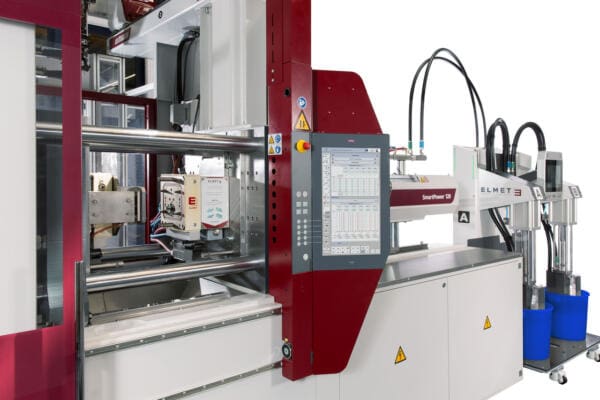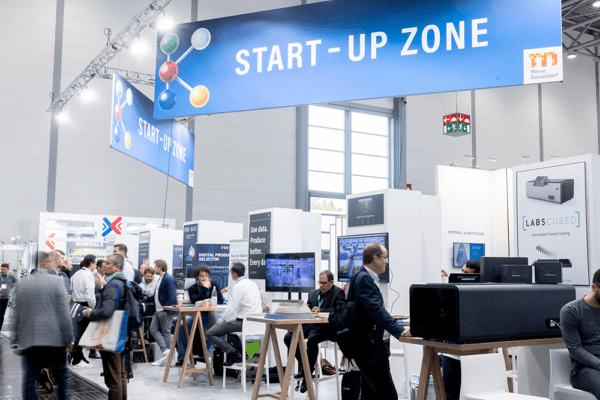
WITTMANN BATTENFELD with Ultra-Modern Injection Moulding Technology and Automation at Interplas
From September 26 to 28, 2023, WITTMANN BATTENFELD will present to visitors at the Interplas in Birmingham, hall 3A, booth No. CC10, state-of-the-art injection moulding technology, automation and auxiliary equipment by way of fascinating applications.
As the leading plastics trade fair in Britain, the Interplas in Birmingham is also an important platform for the WITTMANN Group to introduce its latest technologies to the UK market jointly with its local subsidiary. Among other things, WITTMANN will demonstrate its expertise in the area of LSR processing and in processing alternative, bio-based materials.
SmartPower 120/350 LIM
A major focus of the machine presentation lies on the processing of special materials. On a SmartPower 120/350 LIM, an optical lens for motor vehicle headlamps, known as SMARTlens, will be manufactured with a single-cavity mould supplied by the Austrian company Elmet, made of DOW Corning MS-5002, an injectable 2-component silicone, for Adaptive Driving Beam (ADB). This material was specially developed for highly transparent optical applications. The lens weighs just 10.38 grams. The mould has ventilation and overflow mechanisms for smooth production and maximum performance. Moreover, SIGMASOFT mould flow technology is used for mould analysis, enabling a preliminary simulation to shorten the design and sampling phase.
In preparation, the simulation software has been used in designing the mould. The dosing pump from Elmet is a SMARTmix TOP 7000 pro, the latest model. With a footprint of only 1,150 x 790 mm, it features the lowest space requirements of all dosing systems suitable for 200-litre barrels currently on the market. This also reduces the quantity of LSR present inside the system, which, in turn, increases process reliability and reduces the rinsing volume.
EcoPower 110/350
In the second application, a bio-building block made of Fasal is manufactured on an EcoPower 110/350 with the new B8X control system, using an 8-cavity mould supplied by Bioblo, Austria. This raw material is a compound made by Fasal Wood GmbH, Austria, from wood flour and post-industrial polypropylene supplied by Borealis, Austria. The equipment is designed as an Insider cell, which has a W918 robot and an S-Max 3 screenless granulator from WITTMANN, a conveyor belt, and the protective housing all integrated in the production system.
The W918 robot removes the moulded parts and the sprue, and the sprue is passed on directly to the granulator, where it is ground and then returned to the process. The finished parts are deposited on the integrated conveyor belt, transported to a flow wrapping machine and packaged.
To ensure top quality for the parts, the software packages HiQ Metering for active closing of the check valve and HiQ Melt for measuring the MFI are used in addition to HiQ Flow. The resulting MFR (melt flow rate) is an indicator of the material’s flow attributes.
WITTMANN Sonic 143
In the area of automation, WITTMANN BATTENFELD UK Ltd. will demonstrate the function of the Sonic highspeed robot by means of a chess game with a WITTMANN Sonic 143. The robot is equipped with a combined A/C servo axis and an L-shaped gripper fitted with two individual magnetic gripping systems to handle the chess pieces. The second one of these two grippers comes into play whenever a chess piece is to be captured, that is, replaced by another piece on a particular field.

At the WITTMANN BATTENFELD booth, all visitors are offered the opportunity to compete against the Sonic 143 in a lightning chess game with 3 min playing time, where they can enter their moves via a virtual chess board shown on the display of the WITTMANN R9 TeachBox.
ErgoRobot
The low energy consumption of the WITTMANN robot series will be demonstrated at the Interplas by an interactive showpiece known as the ErgoRobot. This application consists of a robot and a bike used as an ergometer. The trade fair visitor serves as the “power source”. While riding the bike he sets the robot in motion. The robot used in this case is a Primus 14 in the standard version with an R8 control system, an appliance normally used for pick & place applications on machines with clamping forces ranging from 50 to 150 t. The moving bike pedals drive via force transmission a servo motor mounted on the rear wheel. In the ErgoRobot application, this motor functions as the robot’s power supply. The electricity generated by the motor is transmitted to the robot and sets it in motion.
To enable the Primus 14 to move at 100% of its top speed, the bike rider must generate about 150 watts of power. This is roughly the power required by an average refrigerator with a freezer compartment to suit a four-person household. If more power is generated on the bike, the surplus is used to light two-floor lamps next to it. The brightness of the lamps then depends on the amount of additional power supplied.







